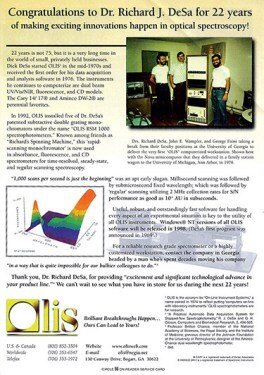The Facts About Uv/vis/nir Revealed
The Facts About Uv/vis/nir Revealed
Blog Article
The Facts About Spectrophotometers Uncovered
Table of ContentsSome Known Details About Circularly Polarized Luminescence Little Known Facts About Circular Dichroism.All about Circular DichroismSome Ideas on Circularly Polarized Luminescence You Should KnowRumored Buzz on Circularly Polarized Luminescence

Spectrophotometry is most commonly applied to ultraviolet, noticeable, and infrared radiation, modern spectrophotometers can interrogate broad swaths of the electro-magnetic spectrum, consisting of x-ray, ultraviolet, noticeable, infrared, and/or microwave wavelengths. Spectrophotometry is a tool that depends upon the quantitative analysis of molecules depending upon how much light is taken in by colored compounds.
Excitement About Spectrophotometers
A spectrophotometer is typically utilized for the measurement of transmittance or reflectance of services, transparent or opaque solids, such as refined glass, or gases. Although lots of biochemicals are colored, as in, they soak up visible light and therefore can be measured by colorimetric treatments, even colorless biochemicals can often be converted to colored compounds suitable for chromogenic color-forming responses to yield substances suitable for colorimetric analysis.: 65 However, they can likewise be created to determine the diffusivity on any of the noted light ranges that normally cover around 2002500 nm using different controls and calibrations.
An example of an experiment in which spectrophotometry is utilized is the decision of the stability constant of a service. A particular chain reaction within an option might occur in a forward and reverse instructions, where reactants form items and items break down into reactants. At some time, this chain reaction will reach a point of balance called a balance point.
Uv/vis Can Be Fun For Anyone
The quantity of light that goes through the service is indicative of the concentration of particular chemicals that do not allow light to pass through. The absorption of light is due to the interaction of light with the electronic and vibrational modes of molecules. Each type of particle has a specific set of energy levels connected with the makeup of its chemical bonds and nuclei and therefore will absorb light of specific wavelengths, or energies, resulting in distinct spectral homes.
Making use of spectrophotometers spans different clinical fields, such as physics, products science, chemistry, biochemistry. circularly polarized luminescence, chemical engineering, and molecular biology. They are extensively utilized in numerous industries consisting of semiconductors, laser and optical production, printing and forensic examination, in addition to in laboratories for the research study of chemical compounds. Spectrophotometry is often utilized in measurements of enzyme activities, decisions of protein concentrations, determinations of enzymatic kinetic constants, and measurements of ligand binding reactions.: 65 Ultimately, a spectrophotometer is able to identify, depending upon the control or calibration, what substances exist in a target and precisely just how much through calculations of observed wavelengths.
This would come as a service to the previously developed spectrophotometers which were unable to absorb the ultraviolet properly.
What Does Circularly Polarized Luminescence Mean?
It would be discovered that this did not give Visit Website satisfactory outcomes, therefore in Design B, there was a shift from a glass to a quartz prism which enabled much better absorbance outcomes - circular dichroism (http://go.bubbl.us/df2308/dba3?/New-Mind-Map). From there, Design C was born with a change to the wavelength resolution which wound up having 3 systems of it produced
It irradiates the sample with polychromatic light which the sample takes in depending upon its homes. Then it is sent back by grating the photodiode array which spots the wavelength area of the spectrum. Ever since, the production and implementation of spectrophotometry devices has increased profoundly and has turned into one of the most ingenious instruments of our time.

Some Known Details About Uv/vis/nir
Historically, spectrophotometers use a monochromator consisting of a diffraction grating to produce the analytical spectrum. The grating can either be movable or repaired. If a single detector, such as a photomultiplier tube or photodiode is used, the grating can be scanned stepwise (scanning spectrophotometer) so that the detector can determine the light strength at each wavelength (which will correspond to each "action").
In such systems, the grating is fixed and the strength of each wavelength of light is determined by a different detector in the variety. When making transmission measurements, the spectrophotometer quantitatively compares the fraction of light that passes through a referral option and a test service, then digitally compares the intensities of the 2 signals and computes the percentage of transmission of the sample compared to the referral standard.

Report this page